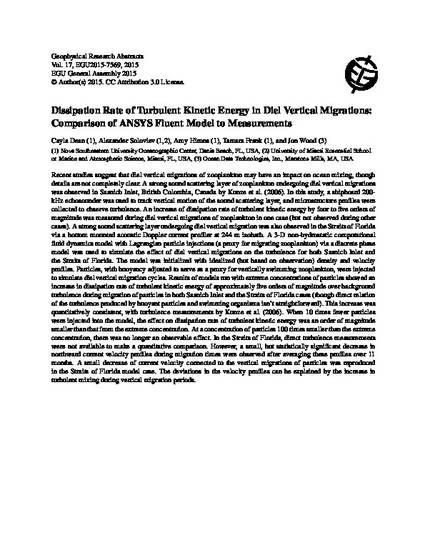
Recent studies suggest that diel vertical migrations of zooplankton may have an impact on ocean mixing, though details are not completely clear. A strong sound scattering layer of zooplankton undergoing diel vertical migrations was observed in Saanich Inlet, British Colombia, Canada by Kunze et al. (2006). In this study, a shipboard 200- kHz echosounder was used to track vertical motion of the sound scattering layer, and microstructure profiles were collected to observe turbulence. An increase of dissipation rate of turbulent kinetic energy by four to five orders of magnitude was measured during diel vertical migrations of zooplankton in one case (but not observed during other cases). A strong sound scattering layer undergoing diel vertical migration was also observed in the Straits of Florida via a bottom mounted acoustic Doppler current profiler at 244 m isobath. A 3-D non-hydrostatic computational fluid dynamics model with Lagrangian particle injections (a proxy for migrating zooplankton) via a discrete phase model was used to simulate the effect of diel vertical migrations on the turbulence for both Saanich Inlet and the Straits of Florida. The model was initialized with idealized (but based on observation) density and velocity profiles. Particles, with buoyancy adjusted to serve as a proxy for vertically swimming zooplankton, were injected to simulate diel vertical migration cycles. Results of models run with extreme concentrations of particles showed an increase in dissipation rate of turbulent kinetic energy of approximately five orders of magnitude over background turbulence during migration of particles in both Saanich Inlet and the Straits of Florida cases (though direct relation of the turbulence produced by buoyant particles and swimming organisms isn’t straightforward). This increase was quantitatively consistent, with turbulence measurements by Kunze et al. (2006). When 10 times fewer particles were injected into the model, the effect on dissipation rate of turbulent kinetic energy was an order of magnitude smaller than that from the extreme concentration. At a concentration of particles 100 times smaller than the extreme concentration, there was no longer an observable effect. In the Straits of Florida, direct turbulence measurements were not available to make a quantitative comparison. However, a small, but statistically significant decrease in northward current velocity profiles during migration times were observed after averaging these profiles over 11 months. A small decrease of current velocity connected to the vertical migrations of particles was reproduced in the Straits of Florida model case. The deviations in the velocity profiles can be explained by the increase in turbulent mixing during vertical migration periods.
Oral presentation from Session: Scale, scaling and uncertainty in the climate, climate and climate models, in the ocean, atmosphere and hydrosphere
Session Abstract:
Due to internal nonlinearities, as well as both natural and anthropogenic
external forcings, the climate system (atmosphere, cryosphere, biosphere, lithosphere, hydrosphere) is variable over huge ranges of space and time scales. This variability is inextricably linked to uncertainties in both models and in empirical analyses. This session aims to bring together climate modellists, paleoclimate researchers and nonlinear
geoscientists. Papers are solicited that:
a) Systematically compare and contrast the statistical variability and
uncertainties of forcings and responses in space and in time of
instrumental and paleo data as well as with model outputs.
b) Use spectra, wavelets or related analysis techniques to statistically
characterize and understand climate data, paleodata and model outputs over
wide ranges of scale.
c) Use deterministic or stochastic models having space-time variability over wide ranges. This includes GCM's, Stochastic Linear Forcing models, scaling (fractal, multifractal) and chaotic models.
Available at: http://works.bepress.com/amy-hirons/12/

© Author(s) 2015. CC Attribution 3.0 License.